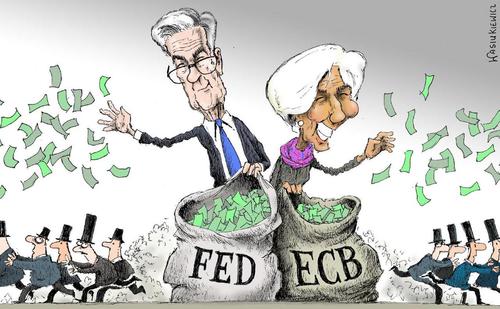This Time Is Not Different. More Debt, Less Growth
I remember that in 2009 three messages were constantly repeated:
“In this crisis measures are different, because governments are investing in the recovery by increasing public spending,” “the funds from stimulus plans will strengthen the recovery “and “central banks help a stronger recovery by lowering rates and increasing liquidity”.
Then, 2010 arrived and the Eurozone entered a deeper crisis.
In many aspects, this recession is similar.
Many governments are doing the same as they did in 2009. Extend and pretend. Extend structural imbalances and pretend this time will be different.
It is worrying to see the same level of excessive optimism of 2009 these days, and we must prepare for a complex environment and a difficult recovery if we are to emerge from this crisis stronger.
A recent analysis by Ned Davis Research shows that as government debt rises, growth slows, and jobs recovery is weaker. Using a multi-factor mode analysis with data from 1951 to 2020, as government debt to GDP exceeds 100%, real growth per annum falls to 1.6%, non-residential investment falls and non-farm payroll recovery weakens to 0.6% per annum.
Two factors tell us that the recovery in 2021 will likely be disappointing.
-
Massive liquidity injections, with $26 trillion injected by central banks, have been used mostly to perpetuate elevated government spending, fundamentally current spending, and fund public debt.
-
The second is that corporate balance sheets have been damaged to a level that will make it difficult to see a significant growth in investment above depreciation. SP Global expects global capital expenditure to remain weak in 2021.
Global growth estimates look too optimistic. The consensus assumes a recovery of 4% globally in 2021, returning to the GDP of 2019 at the end of 2022. This assumes an extraordinary and unprecedented fiscal multiplier of debt and liquidity. One of the most important concerns is to see a recovery in GDP led by a bloated public spending and record debt that would not generate enough employment growth. This is what is called a jobless K-shaped recovery, where some sectors rebound rapidly (technology, high added-value sectors) and a majority (Small and medium enterprises, self-employed) either do not recover or worsen.
In this crisis, developed countries have had an enormous fiscal space at their disposal to face the pandemic. An economy doped by high liquidity and low rates. Some countries have used part of this fiscal space to preserve the business fabric and help create jobs. Others, a majority, have taken the crisis opportunity to increase structural imbalances and current spending without real economic return. This means that there is an important risk of a jobless recovery where furloughed jobs are not absorbed entirely.
A solvency crisis cannot be solved with liquidity. All the central bank quantitative easing programs do not prevent the bankruptcy domino from accelerating in 2021, just as we saw in Europe after the 2009 optimism. This financial crisis after an optimist period comes because the challenged of the economy do not come from lack of access to debt or low rates, but working capital rising way above sales.
Expectations regarding the impact of the European Recovery Fund seem exaggerated. Too much hope is being placed on the magic of the Keynesian multiplier effect of these funds, despite the evidence of their low effectiveness, already contrasted after the disappointment of the Growth Plan and Employment 2009 plan and the Juncker Plan. The probability that these funds will be misused and unproductively is high.
When I look at the estimates of GDP growth for 2021-2022, I see that consensus estimates assume a 1.5x to 2x multiplier to the stimulus packages implemented in 2020. This is almost impossible because it has not happened in the past three decades, there is evidence that the multiplier is very low or zero. The study of Ilzetzki et al” How Big (Small?) Are Fiscal Multipliers? “ (Journal of Monetary Economics, Volume 60, Issue 2, March 2013) shows the history of the cumulative impact of public spending in 44 countries, showing the very low effectiveness of fiscal stimuli. Even if we accepted positive fiscal multipliers, the empirical evidence of the last fifteen years shows a range that, when positive, moves barely between 0.5 and 1 at most. However, in most countries has been negative (as reflected in the FT article “Has the IMF proved multipliers are really large?“, and “Growth Forecast Errors and Fiscal Multipliers” IMF study).
What can be expected?
Some relevant downgrades to GDP growth estimates in those countries with the highest indebtedness and where the fiscal space has been used to perpetuate current government spending and finance automatic stabilizers.
We may also see a large increase in debt as GDP growth undershoots expectations and deficits remain elevated, something that will impact 2022 estimates as well. As governments may decide to raise taxes to finance part of the deficit increase, the impact on jobs and growth will likely be larger.
There is also an important factor to consider. Gross Capital formation may likely disappoint as 2020 has seen an unprecedented zombification of the economy which has led to an abnormal rise in overcapacity for such a short crisis with a large bounce in the third quarter of 2020.
Fiscal and monetary space and are not excuses for counter-reforms and wasting money. Countries have the unique opportunity to use these tools to strengthen the productive fabric and create employment, but unfortunately a large part has been squandered.
There is only one way to strengthen the recovery: To reduce structural imbalances by regaining budgetary sanity and implementing serious measures to attract capital. To fall back into propagandistic optimism would be a mistake.
https://ift.tt/34Xn3Um
from ZeroHedge News https://ift.tt/34Xn3Um
via IFTTT





0 comments
Post a Comment